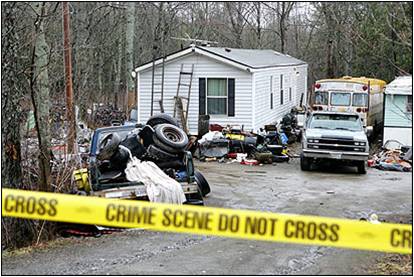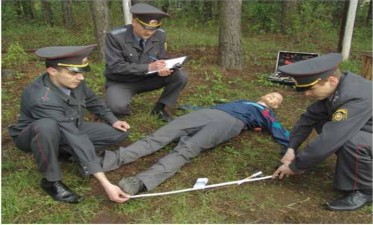| ||||||||||||||||||||||||||||||||||||||||||||||||||||||||||||||||||||||||||||||
|
|
| |||||||||||||||||||||||||||||||||||||||||||||||||||||||||||||||||||||||||||||
|
Unit 8 Forensic Study. Observation of a crime scene
UNIT 8
Forensic Study. Observation of a Crime Scene
Forensics is the term given to an investigation of a crime using scientific means. It is also used as a synonym for "related to courts". The word forensic is derived from the Latin word “forum”, which means “the market place”. In Roman society, justice was administered in the market place. We continue to use the word forum for a public speaking place and have adopted the word forensic as the name for anything related to the administration of justice. There are many professional fields within forensic science: сhemistry, biology, physical science. Each professional field in forensic science is based on a common type of evidence which is often found at crime scenes. Forensic science can be used to identify and incriminate suspects, by studying fingerprints, blood types or DNA profiles for example. It can also be used to prove or disprove claims made by suspects about an incident. What is a crime scene? The crime scene means the place or the area where the crime such as burglary, larceny, homicide, traffic crime or motor vehicle theft, etc. has taken place. The scene is the central location towards which all evidence point before, during and after a crime. Crime scene search is an action of the investigator consisting of his direct survey of the happening, finding, collecting and protecting evidence to establish circumstances, which are significant for the investigator. To observe and examine a crime scene properly is essential for quick and accurate crime solution. It is one of the most important sources of information concerning commission of the crime, which enables the officer to answer with specific details the questions: Where? When? What? Who? Why? How? By means of what? Not infrequently an experienced investigator manages to narrow the investigation and search down to a single individual after a careful study of the crime scene. The process of a crime scene search usually includes preliminary, general observation, detailed search and final stages. At the preliminary stage the investigator keeps in mind the problems of ensuring crime scene protection, preparation of proper crime techniques, choosing and instructing witnesses, getting information of the happening. And of course he gives first aid to a victim, if it is necessary, or calls for an ambulance. At the stage of general observation the investigator is to observe the general appearance of the situation noting everything at the scene. To conduct crime scene search properly the investigator must reconstruct the happening, analyze the operational conditions, make an estimate of the situation and develop and follow a definite way of doing his job. He makes a plan of the search minding not to destroy and overlook any valuable evidence. He also ensures taking pictures of the scene and its objects, making plaster casts of footprints and developing and taking fingerprints. At the stage of detailed examination the investigator tries to answer a lot of different questions: Is it possible to identify the salient features of criminal’s modus operandi? What are these features? Where was the entrance to the scene? What approaches are there to the scene? What was the criminal’s way of entering it? Are there any traces of criminal act, e.g. fingerprints, footprints, blood stains on the objects? Whose prints are they? Was the criminal moving any objects from their positions? Was the criminal alone or in a company with another? Do they always work together? What were they going to do? What instruments do they usually use? What instruments did the criminals use in that case? Are there cigarette stubs or ashes? Does the criminal smoke cigars or cigarettes? Was he smoking at the crime scene? Who can it be? What are his distinctive marks? What was strange in his actions? Why did he behave so strangely? The successful investigator does not forget to note negative facts: Why is the weapon absent? Why are there no fingerprints or blood stains when it is natural to find them? etc. The answers to all those and many other questions help the investigator to build a hypothesis of the crime commission. At the final part of observation the investigator makes the conclusions taking into consideration all available information, packs the traces for a crime laboratory, makes the record of the crime observation and, if necessary, brings a criminal action.
А
Task 1. Give the English for: угон автотранспортного средства; принимать во внимание; оказывать первую помощь; снимать отпечатки пальцев; предварительный; оружие; пятна крови; возбуждать уголовное дело; составлять рапорт; обстоятельство; кража; существенный.
Task 2. Match English and Russian equivalents:
Task 3. Complete the sentences: 1) The crime scene means the place or … 2) Crime scene search is an action of … 3) The process of crime scene search usually includes … 4) At the preliminary stage … 5) At the stage of general observation … 6) At the stage of detailed examination… 7) At the final part of observation…
Task 4. Agree or disagree: 1) The crime scene is the central location towards which all evidence points before, during and after a crime. 2) Crime scene observation is not important for the investigation of crime. 3) The process of a crime scene search usually includes one stage. 4) At the preliminary stage the investigator makes a plan. 5) At the stage of general observation the investigator ensures crime scene protection. 6) At the stage of detailed examination the investigator gives first aid to a victim. 7) At the final part of observation the investigator brings a criminal action.
Task 5. Answer the questions:
B
Task 1. Make the summary and annotation of the text: Identity in Robbery
The main purpose of an investigation of robbery is to find means by which the robber can be identified. The corpus delicti is usually easily proved by the evidence obtained from the victim. Identity in some cases may be made by the victim or other witnesses who recognized the robber by some identifying characteristics in his face or body, speech, clothing, mannerisms, license plates, etc. Witnesses may be able to identify his picture from others in identification bureaus. The description of the robber may correspond to some person in the vicinity and be identified that way. Sometimes identity may be learnt through fingerprints, footprints, fibres or other physical evidence that will reveal a suspect. Ownership or possession of weapons can also be identified. Identity is also sometimes established by confession. Once the identity of the robber is known, the next step is to apprehend him unless he is already taken. If taken and identified, the case is ready for the prosecution. Task 2. Read and translate the text: Identity in Burglary
The search for the identity of the burglar should begin at the very outset of an investigation. Once the investigation has established the corpus delicti of burglary, the investigation should be centred on the identity and apprehension of the burglar. Identity of the burglar may be established in many ways. Many burglars are seen by people inside the place and are apprehended and identified by their description of then. Sometimes witnesses may see the burglar, but not realize that a burglary has been committed until later. Eyewitness may identify such suspects, describe a known burglar, or someone who was acting suspiciously near the place. An investigation of known burglars may reveal that this person was in the vicinity. Examination of the modus operandi may reveal evidence of similar characteristics in a known burglar's handiwork. Stolen goods may be found, traced to the burglar and his identity established. A suspect may be away from his usual place at the time the burglary was committed. Fingerprints, footsteps, tool-markings and other physical evidence may establish leads to identity. Flight or absences of a certain person during an investigation may give leads to clues to his identity. All these characteristics and many others may be the means which first point to a certain person as suspected, and, later, identify the burglar. Identity is best established when there are confessions, admissions, or identifications by eyewitnesses. If the evidence allows presumption of guilt, the case is ready for the prosecution and arrest. Task 3. Read and translate the text: Identity of the Vehicle
Ownership and identity of the vehicle is established usually by the license plates, the owner registration card, and by the aerial numbers of the car and other identification. These should be with the motor vehicle at all times. Identity is further aided by knowledge of the make, style and the year in which the vehicle was manufactured. The vehicle is identified to establish ownership and the owner’s legal responsibility. One of the owner’s a responsibility is to reveal the name of the operator of the vehicle if the owner was not operating it at the time of the accident. Identity includes knowledge of the identity of the operator involved at the time of the collision. The operator is identified by admission or confession on his part, or by witnesses who saw him while behind the wheel and in control. The physical condition of the operator at the time of collision is important. What happened to him during the collision is also important, for his present physical condition may have been caused by injuries deceived in the collision. Identifying the operator reveals the one in control of the vehicle at the time of collision. Control in both cases depends to some extent on the physical condition of the vehicle and operator. One can expect a change in the ability to control if the vehicle is in motion after a collision, due to shock or damage to the operator or the vehicle. C
| ||||||||||||||||||||||||||||||||||||||||||||||||||||||||||||||||||||||||||||||
|
| ||||||||||||||||||||||||||||||||||||||||||||||||||||||||||||||||||||||||||||||
| © Академия Министерства внутренних дел Республики Беларусь Электронный учебно-методический комплекс | ||||||||||||||||||||||||||||||||||||||||||||||||||||||||||||||||||||||||||||||

